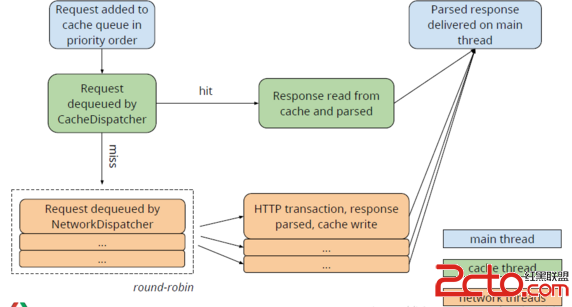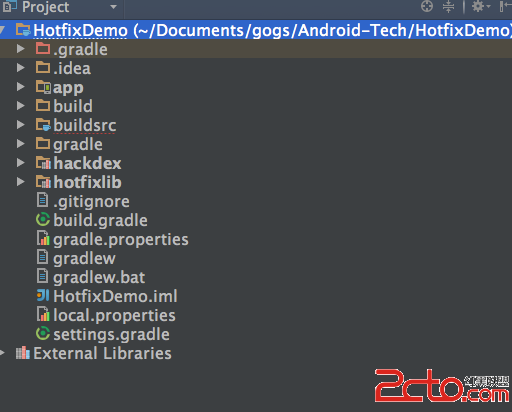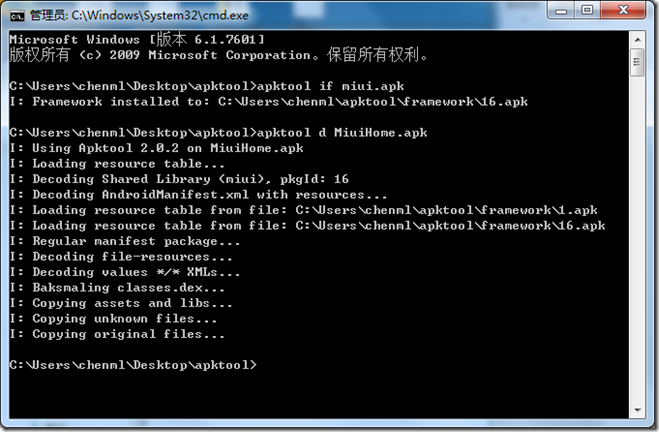編輯:關於android開發
很早之前就想寫下關於Volley的源碼解析。一開始學android網絡訪問都是使用HttpClient,剛接觸麼Volley的時候就瞬間愛不釋手,雖說現在項目中使用OkHttp多些(Volley更新慢),但是作為google自家推出的網絡框架,Volley還是有很多值得學習的地方。這篇博客是我對Volley源碼分析後的一個總結。
Volley的使用非常簡單,相信大家都很熟悉。首先需要獲取到一個RequestQueue對象。
RequestQueue mQueue = Volley.newRequestQueue(context);
如果想通過網絡獲取json,如下:
StringRequest stringRequest = new StringRequest("http://www.baidu.com",
new Response.Listener() {
@Override
public void onResponse(String response) {
Log.d("TAG", response);
}
}, new Response.ErrorListener() {
@Override
public void onErrorResponse(VolleyError error) {
Log.e("TAG", error.getMessage(), error);
}
});
只要在onResponse中處理返回的response即可。如果訪問出錯,則會調用onErrorResonse方法。 注意Volley是異步,是在子線程中進行網絡訪問,而onResponse裡的代碼是在主線程中執行。所以使用Volley的地方切記不要把它當成單線程,這是初學者經常犯錯的地方。最後,將這個StringRequest對象添加到RequestQueue裡面就可以了。
mQueue.add(stringRequest);
如果要加載圖片,則首先要定義一個ImageCache,用於定義圖片的緩存。通過ImageLoader來加載圖片,ImageListener則用於指定ImageView以及加載失敗和加載過程中默認圖片 :
private final LruCache mLruCache = new LruCache(
(int) (Runtime.getRuntime().maxMemory() / 10))
{
@Override
protected int sizeOf(String key, Bitmap value)
{
return value.getRowBytes() * value.getHeight();
}
};
@Override
public void putBitmap(String url, Bitmap bitmap)
{
mLruCache.put(url, bitmap);
}
@Override
public Bitmap getBitmap(String url)
{
return mLruCache.get(url);
}
});
ImageListener listener = ImageLoader.getImageListener(imageView,
R.drawable.default, R.drawable.failed);
imageLoader.get(imageurl, listener);
介紹完簡單用法之後,就來分析源代碼了。
先看下官網給出的介紹圖:
 vc34wufH68fzttPB0NbQo6zIu7rztKbA7beiy81IVFRQx+vH86OsveLO9s/s06a94bn7o6zQtMjru7q05qOssqK72LX31vfP37PMoaO908/CwLTP6s+4tcS9+NDQt9bO9qGjPGJyIC8+DQqyu9PDy7WjrMjrv9q/z7aoysdWb2xsZXkubmV3UmVxdWVzdFF1ZXVlKGNvbnRleHQpoaPPyL+0z8JuZXdSZXF1ZXN0UXVldWW1xLT6wuujujwvcD4NCjxwcmUgY2xhc3M9"brush:java;">
vc34wufH68fzttPB0NbQo6zIu7rztKbA7beiy81IVFRQx+vH86OsveLO9s/s06a94bn7o6zQtMjru7q05qOssqK72LX31vfP37PMoaO908/CwLTP6s+4tcS9+NDQt9bO9qGjPGJyIC8+DQqyu9PDy7WjrMjrv9q/z7aoysdWb2xsZXkubmV3UmVxdWVzdFF1ZXVlKGNvbnRleHQpoaPPyL+0z8JuZXdSZXF1ZXN0UXVldWW1xLT6wuujujwvcD4NCjxwcmUgY2xhc3M9"brush:java;">
public static RequestQueue newRequestQueue(Context context, HttpStack stack) {
File cacheDir = new File(context.getCacheDir(), DEFAULT_CACHE_DIR);
String userAgent = "volley/0";
try {
String packageName = context.getPackageName();
PackageInfo info = context.getPackageManager().getPackageInfo(packageName, 0);
userAgent = packageName + "/" + info. versionCode;
} catch (NameNotFoundException e) {
}
if (stack == null) {
if (Build.VERSION. SDK_INT >= 9) {
stack = new HurlStack();
} else {
// Prior to Gingerbread, HttpUrlConnection was unreliable.
// See: http://android-developers.blogspot.com/2011/09/androids-http-clients.html
stack = new HttpClientStack(AndroidHttpClient. newInstance(userAgent));
}
}
Network network = new BasicNetwork(stack);
RequestQueue queue = new RequestQueue( new DiskBasedCache(cacheDir), network);
queue.start();
return queue;
}
首先封裝得到userAgent,User-Agent 字段設置為 App 的packageName/{versionCode},如果異常則使用 “volley/0”。上面代碼主要是實例化stack ,如果SDK版本大於9,使用HurlStack,否則使用HttpClientStack。實際上HurlStack的內部就是使用HttpURLConnection進行網絡通訊的,而HttpClientStack的內部則是使用HttpClient進行網絡通訊的。也就是說android2.2以上的都是使用HttpURLConnection,否則使用HttpClient。接著new了一個RequestQueue,並調用它的start方法。來看下它的RequestQueue構造方法:
/** Number of network request dispatcher threads to start. */
private static final int DEFAULT_NETWORK_THREAD_POOL_SIZE = 4;
/** Cache interface for retrieving and storing responses. */
private final Cache mCache;
/** Network interface for performing requests. */
private final Network mNetwork;
/** Response delivery mechanism. */
private final ResponseDelivery mDelivery;
/** The network dispatchers. */
private NetworkDispatcher[] mDispatchers;
public RequestQueue(Cache cache, Network network, int threadPoolSize,
ResponseDelivery delivery) {
mCache = cache;
mNetwork = network;
mDispatchers = new NetworkDispatcher[threadPoolSize];
mDelivery = delivery;
}
初始化主要就是4個參數:mCache、mNetwork、mDispatchers、mDelivery。第一個是硬盤緩存;第二個主要用於Http相關操作;第三個用於轉發請求的;第四個參數用於把結果轉發到UI線程,通過它來對外聲明接口。接下來看下start方法。
private static final int DEFAULT_NETWORK_THREAD_POOL_SIZE = 4;
/** Cache interface for retrieving and storing responses. */
private final Cache mCache;
/** Network interface for performing requests. */
private final Network mNetwork;
/** Response delivery mechanism. */
private final ResponseDelivery mDelivery;
/** The network dispatchers. */
private NetworkDispatcher[] mDispatchers;
/**
* Starts the dispatchers in this queue.
*/
public void start() {
stop(); // Make sure any currently running dispatchers are stopped.
// Create the cache dispatcher and start it.
mCacheDispatcher = new CacheDispatcher(mCacheQueue, mNetworkQueue, mCache, mDelivery);
mCacheDispatcher.start();
// Create network dispatchers (and corresponding threads) up to the pool size.
for (int i = 0; i < mDispatchers.length; i++) {
NetworkDispatcher networkDispatcher = new NetworkDispatcher(mNetworkQueue, mNetwork,
mCache, mDelivery);
mDispatchers[i] = networkDispatcher;
networkDispatcher.start();
}
}
/**
* Stops the cache and network dispatchers.
*/
public void stop() {
if (mCacheDispatcher != null) {
mCacheDispatcher.quit();
}
for (int i = 0; i < mDispatchers.length; i++) {
if (mDispatchers[i] != null) {
mDispatchers[i].quit();
}
}
}
首先調用stop()方法,確保此時所有轉發器都處於停止狀態。接下來就new了一個CacheDispatcher轉發器,它其實就是一個線程,用於硬盤緩存。再new了四個NetworkDispatcher轉發器,用於網絡請求。並分別調用這些線程的start()方法。如果是加載圖片,我們還需定義一個imageLoader,來看看Volley中為我們定義的ImageLoader,主要看它的get方法:
public ImageContainer get(String requestUrl, ImageListener imageListener,
int maxWidth, int maxHeight) {
// only fulfill requests that were initiated from the main thread.
throwIfNotOnMainThread();
final String cacheKey = getCacheKey(requestUrl, maxWidth, maxHeight);
// Try to look up the request in the cache of remote images.
Bitmap cachedBitmap = mCache.getBitmap(cacheKey);
if (cachedBitmap != null) {
// Return the cached bitmap.
ImageContainer container = new ImageContainer(cachedBitmap, requestUrl, null, null);
imageListener.onResponse(container, true);
return container;
}
// The bitmap did not exist in the cache, fetch it!
ImageContainer imageContainer =
new ImageContainer(null, requestUrl, cacheKey, imageListener);
// Update the caller to let them know that they should use the default bitmap.
imageListener.onResponse(imageContainer, true);
// Check to see if a request is already in-flight.
BatchedImageRequest request = mInFlightRequests.get(cacheKey);
if (request != null) {
// If it is, add this request to the list of listeners.
request.addContainer(imageContainer);
return imageContainer;
}
// The request is not already in flight. Send the new request to the network and
// track it.
Request newRequest =
new ImageRequest(requestUrl, new Listener() {
@Override
public void onResponse(Bitmap response) {
onGetImageSuccess(cacheKey, response);
}
}, maxWidth, maxHeight,
Config.RGB_565, new ErrorListener() {
@Override
public void onErrorResponse(VolleyError error) {
onGetImageError(cacheKey, error);
}
});
mRequestQueue.add(newRequest);
mInFlightRequests.put(cacheKey,
new BatchedImageRequest(newRequest, imageContainer));
return imageContainer;
}
上面代碼具體流程是這樣,首先通過throwIfNotOnMainThread()方法限制必須在UI線程調用;然後根據傳入的參數計算cacheKey,獲取緩存;如果存在cache,直接將返回結果封裝為一個ImageContainer,然後直接回調imageListener.onResponse(container, true);這時我們就可以設置圖片了。如果不存在,那就初始化一個ImageContainer,然後直接回調imageListener.onResponse(imageContainer, true),這裡是為了讓我們設置默認圖片。所以,在實現listener的時候,要先判斷resp.getBitmap()是否為null;接下來檢查該url是否早已加入了請求對了,如果已加入,則將剛初始化的ImageContainer加入BatchedImageRequest。這就是加載圖片時的內存緩存。
然後調用RequestQueue的add()方法將Request傳入就可以完成網絡請求操作了,讓我們來看看add方法中到底做了什麼事。
private final Map>> mWaitingRequests =
new HashMap>>();
/**
* The set of all requests currently being processed by this RequestQueue. A Request
* will be in this set if it is waiting in any queue or currently being processed by
* any dispatcher.
*/
private final Set> mCurrentRequests = new HashSet>();
/** The cache triage queue. */
private final PriorityBlockingQueue< Request> mCacheQueue =
new PriorityBlockingQueue< Request>();
/** The queue of requests that are actually going out to the network. */
private final PriorityBlockingQueue< Request> mNetworkQueue =
new PriorityBlockingQueue< Request>();
/**
* Adds a Request to the dispatch queue.
* @param request The request to service
* @return The passed -in request
*/
public Request add(Request request) {
// Tag the request as belonging to this queue and add it to the set of current requests.
request.setRequestQueue( this);
synchronized ( mCurrentRequests) {
mCurrentRequests.add(request);
}
// Process requests in the order they are added.
request.setSequence(getSequenceNumber());
request.addMarker( "add-to-queue");
// If the request is uncacheable, skip the cache queue and go straight to the network.
if (!request.shouldCache()) {
mNetworkQueue.add(request);
return request;
}
// Insert request into stage if there's already a request with the same cache key in flight.
synchronized ( mWaitingRequests) {
String cacheKey = request.getCacheKey();
if ( mWaitingRequests.containsKey(cacheKey)) {
// There is already a request in flight. Queue up.
Queue> stagedRequests = mWaitingRequests .get(cacheKey);
if (stagedRequests == null) {
stagedRequests = new LinkedList>();
}
stagedRequests.add(request);
mWaitingRequests.put(cacheKey, stagedRequests);
if (VolleyLog. DEBUG) {
VolleyLog. v("Request for cacheKey=%s is in flight, putting on hold.", cacheKey);
}
} else {
// Insert 'null' queue for this cacheKey, indicating there is now a request in
// flight.
mWaitingRequests.put(cacheKey, null);
mCacheQueue.add(request);
}
return request;
}
}
這裡首先將請求加入mCurrentRequests,這個mCurrentRequests是一個HashSet,它保存了所有需要處理的Request,主要為了提供cancel的入口。如果該請求不應該被緩存則直接加入mNetworkQueue,然後返回。request.shouldCache()在默認情況下,每條請求都是可以緩存的,當然我們也可以調用Request的setShouldCache(false)方法來改變這一默認行為。
接下來判斷該請求是否有相同的請求正在被處理,如果有則加入mWaitingRequests;如果沒有,則加入mWaitingRequests.put(cacheKey, null),並將request加入到CacheQueue中。
有了隊列,我們就來看看線程是如何執行的。先看CacheDispatcher。
public class CacheDispatcher extends Thread {
private static final boolean DEBUG = VolleyLog.DEBUG;
/** The queue of requests coming in for triage. */
private final BlockingQueue> mCacheQueue;
/** The queue of requests going out to the network. */
private final BlockingQueue> mNetworkQueue;
/** The cache to read from. */
private final Cache mCache;
/** For posting responses. */
private final ResponseDelivery mDelivery;
/** Used for telling us to die. */
private volatile boolean mQuit = false;
/**
* Creates a new cache triage dispatcher thread. You must call {@link #start()}
* in order to begin processing.
*
* @param cacheQueue Queue of incoming requests for triage
* @param networkQueue Queue to post requests that require network to
* @param cache Cache interface to use for resolution
* @param delivery Delivery interface to use for posting responses
*/
public CacheDispatcher(
BlockingQueue> cacheQueue, BlockingQueue> networkQueue,
Cache cache, ResponseDelivery delivery) {
mCacheQueue = cacheQueue;
mNetworkQueue = networkQueue;
mCache = cache;
mDelivery = delivery;
}
/**
* Forces this dispatcher to quit immediately. If any requests are still in
* the queue, they are not guaranteed to be processed.
*/
public void quit() {
mQuit = true;
interrupt();
}
@Override
public void run() {
if (DEBUG) VolleyLog.v("start new dispatcher");
Process.setThreadPriority(Process.THREAD_PRIORITY_BACKGROUND);
// Make a blocking call to initialize the cache.
mCache.initialize();
while (true) {
try {
// Get a request from the cache triage queue, blocking until
// at least one is available.
final Request request = mCacheQueue.take();
request.addMarker("cache-queue-take");
// If the request has been canceled, don't bother dispatching it.
if (request.isCanceled()) {
request.finish("cache-discard-canceled");
continue;
}
// Attempt to retrieve this item from cache.
Cache.Entry entry = mCache.get(request.getCacheKey());
if (entry == null) {
request.addMarker("cache-miss");
// Cache miss; send off to the network dispatcher.
mNetworkQueue.put(request);
continue;
}
// If it is completely expired, just send it to the network.
if (entry.isExpired()) {
request.addMarker("cache-hit-expired");
request.setCacheEntry(entry);
mNetworkQueue.put(request);
continue;
}
// We have a cache hit; parse its data for delivery back to the request.
request.addMarker("cache-hit");
Response response = request.parseNetworkResponse(
new NetworkResponse(entry.data, entry.responseHeaders));
request.addMarker("cache-hit-parsed");
if (!entry.refreshNeeded()) {
// Completely unexpired cache hit. Just deliver the response.
mDelivery.postResponse(request, response);
} else {
// Soft-expired cache hit. We can deliver the cached response,
// but we need to also send the request to the network for
// refreshing.
request.addMarker("cache-hit-refresh-needed");
request.setCacheEntry(entry);
// Mark the response as intermediate.
response.intermediate = true;
// Post the intermediate response back to the user and have
// the delivery then forward the request along to the network.
mDelivery.postResponse(request, response, new Runnable() {
@Override
public void run() {
try {
mNetworkQueue.put(request);
} catch (InterruptedException e) {
// Not much we can do about this.
}
}
});
}
} catch (InterruptedException e) {
// We may have been interrupted because it was time to quit.
if (mQuit) {
return;
}
continue;
}
}
}
}
我們要知道CacheDispatcher是硬盤緩存,到此可知Volley也是有二級緩存的。重點看它的run方法。看到while(true)時,我們就知道,它是在不斷的執行的。首先從mCacheQueue中取出緩存,如果沒有取到,就把它加入mNetworkQueue中,再判斷緩存是否過期,如果過期,也放入mNetworkQueue中。否則就取到了可用的緩存了,再調用request.parseNetworkResponse解析從緩存中取出的data和responseHeaders通過mDelivery.postResponse轉發,然後回調到UI線程;我們看下mDelivery.postResponse方法:
@Override
public void postResponse(Request request, Response response, Runnable runnable) {
request.markDelivered();
request.addMarker("post-response");
mResponsePoster.execute(new ResponseDeliveryRunnable(request, response, runnable));
}
主要看ResponseDeliveryRunnable。
public ResponseDeliveryRunnable(Request request, Response response, Runnable runnable) {
mRequest = request;
mResponse = response;
mRunnable = runnable;
}
@SuppressWarnings("unchecked")
@Override
public void run() {
// If this request has canceled, finish it and don't deliver.
if (mRequest.isCanceled()) {
mRequest.finish("canceled-at-delivery");
return;
}
// Deliver a normal response or error, depending.
if (mResponse.isSuccess()) {
mRequest.deliverResponse(mResponse.result);
} else {
mRequest.deliverError(mResponse.error);
}
// If this is an intermediate response, add a marker, otherwise we're done
// and the request can be finished.
if (mResponse.intermediate) {
mRequest.addMarker("intermediate-response");
} else {
mRequest.finish("done");
}
// If we have been provided a post-delivery runnable, run it.
if (mRunnable != null) {
mRunnable.run();
}
}
在它的run方法中,如果訪問成功會調用mRequest.deliverResponse(mResponse.result)方法,到這裡就很明了了,因為每個request子類中都要重寫deliverResponse,最後我們再在這個方法中將響應的數據回調到Response.Listener的onResponse()方法中就可以了。以StringRequest為例:
@Override
protected void deliverResponse(String response) {
mListener.onResponse (response);
}
分析完緩存,我們來看下網絡加載。它是在NetworkDispatcher線程中實現的。
public class NetworkDispatcher extends Thread {
/** The queue of requests to service. */
private final BlockingQueue> mQueue;
/** The network interface for processing requests. */
private final Network mNetwork;
/** The cache to write to. */
private final Cache mCache;
/** For posting responses and errors. */
private final ResponseDelivery mDelivery;
/** Used for telling us to die. */
private volatile boolean mQuit = false;
/**
* Creates a new network dispatcher thread. You must call {@link #start()}
* in order to begin processing.
*
* @param queue Queue of incoming requests for triage
* @param network Network interface to use for performing requests
* @param cache Cache interface to use for writing responses to cache
* @param delivery Delivery interface to use for posting responses
*/
public NetworkDispatcher(BlockingQueue> queue,
Network network, Cache cache,
ResponseDelivery delivery) {
mQueue = queue;
mNetwork = network;
mCache = cache;
mDelivery = delivery;
}
@Override
public void run() {
Process.setThreadPriority(Process. THREAD_PRIORITY_BACKGROUND);
Request request;
while ( true) {
try {
// Take a request from the queue.
request = mQueue.take();
} catch (InterruptedException e) {
// We may have been interrupted because it was time to quit.
if ( mQuit) {
return;
}
continue;
}
try {
request.addMarker( "network-queue-take" );
// If the request was cancelled already, do not perform the
// network request.
if (request.isCanceled()) {
request.finish( "network-discard-cancelled" );
continue;
}
addTrafficStatsTag(request);
// Perform the network request.
NetworkResponse networkResponse = mNetwork.performRequest(request);
request.addMarker( "network-http-complete" );
// If the server returned 304 AND we delivered a response already,
// we're done -- don't deliver a second identical response.
if (networkResponse. notModified && request.hasHadResponseDelivered()) {
request.finish( "not-modified");
continue;
}
// Parse the response here on the worker thread.
Response response = request.parseNetworkResponse(networkResponse);
request.addMarker( "network-parse-complete" );
// Write to cache if applicable.
// TODO: Only update cache metadata instead of entire record for 304s.
if (request.shouldCache() && response. cacheEntry != null ) {
mCache.put(request.getCacheKey(), response.cacheEntry );
request.addMarker( "network-cache-written" );
}
// Post the response back.
request.markDelivered();
mDelivery.postResponse(request, response);
} catch (VolleyError volleyError) {
parseAndDeliverNetworkError(request, volleyError);
} catch (Exception e) {
VolleyLog. e(e, "Unhandled exception %s", e.toString());
mDelivery.postError(request, new VolleyError(e));
}
}
}
}
首先取出請求;然後通過mNetwork.performRequest(request)處理我們的請求,拿到NetworkResponse。看下performRequest方法:
public NetworkResponse performRequest(Request request) throws VolleyError {
long requestStart = SystemClock.elapsedRealtime();
while (true) {
HttpResponse httpResponse = null;
byte[] responseContents = null;
Map responseHeaders = new HashMap();
try {
// Gather headers.
Map headers = new HashMap();
addCacheHeaders(headers, request.getCacheEntry());
httpResponse = mHttpStack.performRequest(request, headers);
StatusLine statusLine = httpResponse.getStatusLine();
int statusCode = statusLine.getStatusCode();
responseHeaders = convertHeaders(httpResponse.getAllHeaders());
// Handle cache validation.
if (statusCode == HttpStatus.SC_NOT_MODIFIED) {
return new NetworkResponse(HttpStatus.SC_NOT_MODIFIED,
request.getCacheEntry() == null ? null : request.getCacheEntry().data,
responseHeaders, true);
}
// Some responses such as 204s do not have content. We must check.
if (httpResponse.getEntity() != null) {
responseContents = entityToBytes(httpResponse.getEntity());
} else {
// Add 0 byte response as a way of honestly representing a
// no-content request.
responseContents = new byte[0];
}
// if the request is slow, log it.
long requestLifetime = SystemClock.elapsedRealtime() - requestStart;
logSlowRequests(requestLifetime, request, responseContents, statusLine);
if (statusCode < 200 || statusCode > 299) {
throw new IOException();
}
return new NetworkResponse(statusCode, responseContents, responseHeaders, false);
} catch (Exception e) {
……
}
}
}
上面方法主要是網絡請求的一些細節,所以如果要修改請求的細節就要到此處修改(後面會講到)。
在這裡服務器會返回的數據組裝成一個NetworkResponse對象進行返回。在NetworkDispatcher中收到了NetworkResponse這個返回值後又會調用Request的parseNetworkResponse()方法來解析NetworkResponse中的數據,再將數據寫入到緩存。parseNetworkResponse的實現是交給Request的子類來完成的,不同種類的Request解析的方式不同。如json與gson就有區別。最後與CacheDispatcher一樣調用mDelivery.postResponse(request, response)返回回調,這裡就不再分析了。
到這裡volley的源碼就分析完了,總結一下:
volley跟httpClient不一樣,它是不會自動添加cookie頭的。但是cookie在應用中卻很重要,它會保證登陸後的操作都處於一個會話中,有效的增加了安全性。那麼如何在volley中自動添加cookie呢。
首先在新建Appliaction,當成全局的Application,然後在裡面編寫在http頭參數中識別出cookie和添加cookie到Http頭代碼。
/**
* Checks the response headers for session cookie and saves it
* if it finds it.
* @param headers Response Headers.
*/
public static final void checkSessionCookie(Map headers) {
Log.e("TAG", "checkSessionCookie->headers:" + headers);
if (headers.containsKey(GlobalParams.SET_COOKIE_KEY) && headers.get(GlobalParams.SET_COOKIE_KEY).startsWith(GlobalParams.SESSION_COOKIE)) {
String cookie = headers.get(GlobalParams.SET_COOKIE_KEY);
if (cookie.length() > 0) {
//形如Set-Cookie:JSESSIONID=18D6BCC01453C6EB39BB0C4208F389EE; Path=/smdb
//進行解析,取出JSESSIONID的value
String[] splitCookie = cookie.split(";");
String[] splitSessionId = splitCookie[0].split("=");
cookie = splitSessionId[1];
Editor prefEditor = preferences.edit();
prefEditor.putString(GlobalParams.SESSION_COOKIE, cookie);
prefEditor.commit();
}
}else {
if (null != httpclient.getCookieStore()) {
List cookies = httpclient.getCookieStore().getCookies();
for (Cookie cookie : cookies) {
if ("JSESSIONID".equals(cookie.getName())) {//取得session的value
String sessionId = cookie.getValue();
Editor prefEditor = preferences.edit();
prefEditor.putString(GlobalParams.SESSION_COOKIE, sessionId);
prefEditor.commit();
break;
}
}
if (!cookies.isEmpty()) {
for (int i = 0; i < cookies.size(); i++) {
cookie = cookies.get(i);//保存cookie的信息使得HttpClient和WebView共享同一個cookie
}
}
}
}
}
接著就要在Request的子類中合適地方添加頭信息,哪個地方合適。我們來看下HurlStack的performRequest方法。
@Override
public HttpResponse performRequest(Request request, Map additionalHeaders)
throws IOException, AuthFailureError {
String url = request.getUrl();
HashMap map = new HashMap();
map.putAll(request.getHeaders());
map.putAll(additionalHeaders);
if (mUrlRewriter != null) {
String rewritten = mUrlRewriter.rewriteUrl(url);
if (rewritten == null) {
throw new IOException("URL blocked by rewriter: " + url);
}
url = rewritten;
}
URL parsedUrl = new URL(url);
HttpURLConnection connection = openConnection(parsedUrl, request);
for (String headerName : map.keySet()) {
connection.addRequestProperty(headerName, map.get(headerName));
}
setConnectionParametersForRequest(connection, request);
// Initialize HttpResponse with data from the HttpURLConnection.
ProtocolVersion protocolVersion = new ProtocolVersion("HTTP", 1, 1);
int responseCode = connection.getResponseCode();
if (responseCode == -1) {
// -1 is returned by getResponseCode() if the response code could not be retrieved.
// Signal to the caller that something was wrong with the connection.
throw new IOException("Could not retrieve response code from HttpUrlConnection.");
}
StatusLine responseStatus = new BasicStatusLine(protocolVersion,
connection.getResponseCode(), connection.getResponseMessage());
BasicHttpResponse response = new BasicHttpResponse(responseStatus);
response.setEntity(entityFromConnection(connection));
for (Entry> header : connection.getHeaderFields().entrySet()) {
if (header.getKey() != null) {
Header h = new BasicHeader(header.getKey(), header.getValue().get(0));
response.addHeader(h);
}
}
return response;
}
重點看到map.putAll(request.getHeaders());所以我們考慮到如果要給它添加頭信息可以在request的getHeaders()方法中添加。至此我們以StringRequest為例,重寫一個類叫MyStringRequest:
public class MyStringRequest extends StringRequest {
private final Map mParams;
/**
* @param method
* @param url
* @param params
* A {@link HashMap} to post with the request. Null is allowed
* and indicates no parameters will be posted along with request.
* @param listener
* @param errorListener
*/
public MyStringRequest(int method, String url, Map params, Listener listener,
ErrorListener errorListener) {
super(method, url, listener, errorListener);
mParams = params;
}
@Override
protected Map getParams() {
return mParams;
}
/* (non-Javadoc)
* @see com.android.volley.toolbox.StringRequest#parseNetworkResponse(com.android.volley.NetworkResponse)
*/
@Override
protected Response parseNetworkResponse(NetworkResponse response) {
// since we don't know which of the two underlying network vehicles
// will Volley use, we have to handle and store session cookies manually
Log.e("TAG", "parseNetworkResponse->response.headers:" + response.headers);
GlobalApplication.checkSessionCookie(response.headers);
return super.parseNetworkResponse(response);
}
/* (non-Javadoc)
* @see com.android.volley.Request#getHeaders()
*/
@Override
public Map getHeaders() throws AuthFailureError {
Map headers = super.getHeaders();
if (headers == null || headers.equals(Collections.emptyMap())) {
headers = new HashMap();
}
GlobalApplication.addSessionCookie(headers);
return headers;
}
}
在parseNetworkResponse中調用checkSessionCookie解析頭信息中的cookie,然後重寫getHeaders方法,調用addSessionCookie添加cookie。
網絡訪問經常要用到重定向,雖說在客戶端中用得比較少。那Volley能不能進行自動重定向,答案是可以的,重要修改下源碼。既然要重定向,那就要在請求返回的進行判斷,毫無疑問要在BasicNetwork的performRequest中修改,先看下修改後的代碼:
@Override
public NetworkResponse performRequest(Request request) throws VolleyError {
long requestStart = SystemClock.elapsedRealtime();
while (true) {
HttpResponse httpResponse = null;
byte[] responseContents = null;
Map responseHeaders = new HashMap();
try {
// Gather headers.
Map headers = new HashMap();
addCacheHeaders(headers, request.getCacheEntry());
httpResponse = mHttpStack.performRequest(request, headers);
StatusLine statusLine = httpResponse.getStatusLine();
int statusCode = statusLine.getStatusCode();
responseHeaders = convertHeaders(httpResponse.getAllHeaders());
// Handle cache validation.
if (statusCode == HttpStatus.SC_NOT_MODIFIED) {
return new NetworkResponse(HttpStatus.SC_NOT_MODIFIED,
request.getCacheEntry() == null ? null : request.getCacheEntry().data,
responseHeaders, true);
}
// Handle moved resources
//Line143-148為解決301/302重定向問題增加的代碼。
//參考見https://github.com/elbuild/volley-plus/commit/4a65a4099d2b1d942f4d51a6df8734cf272564eb#diff-b4935f77d9f815bb7e0dba85e55dc707R150
if (statusCode == HttpStatus.SC_MOVED_PERMANENTLY || statusCode == HttpStatus.SC_MOVED_TEMPORARILY) {
String newUrl = responseHeaders.get("Location");
request.setRedirectUrl(newUrl);
}
// Some responses such as 204s do not have content. We must check.
if (httpResponse.getEntity() != null) {
responseContents = entityToBytes(httpResponse.getEntity());
} else {
// Add 0 byte response as a way of honestly representing a
// no-content request.
responseContents = new byte[0];
}
// if the request is slow, log it.
long requestLifetime = SystemClock.elapsedRealtime() - requestStart;
logSlowRequests(requestLifetime, request, responseContents, statusLine);
if (statusCode < 200 || statusCode > 299) {
throw new IOException();
}
return new NetworkResponse(statusCode, responseContents, responseHeaders, false);
} catch (SocketTimeoutException e) {
attemptRetryOnException("socket", request, new TimeoutError());
} catch (ConnectTimeoutException e) {
attemptRetryOnException("connection", request, new TimeoutError());
} catch (MalformedURLException e) {
throw new RuntimeException("Bad URL " + request.getUrl(), e);
} catch (IOException e) {
int statusCode = 0;
NetworkResponse networkResponse = null;
if (httpResponse != null) {
statusCode = httpResponse.getStatusLine().getStatusCode();
} else {
throw new NoConnectionError(e);
}
//Line143-148為解決301/302重定向問題增加的代碼。
if (statusCode == HttpStatus.SC_MOVED_PERMANENTLY ||
statusCode == HttpStatus.SC_MOVED_TEMPORARILY) {
VolleyLog.e("Request at %s has been redirected to %s", request.getOriginUrl(), request.getUrl());
} else {
VolleyLog.e("Unexpected response code %d for %s", statusCode, request.getUrl());
}
if (responseContents != null) {
networkResponse = new NetworkResponse(statusCode, responseContents,
responseHeaders, false);
if (statusCode == HttpStatus.SC_UNAUTHORIZED ||
statusCode == HttpStatus.SC_FORBIDDEN) {
attemptRetryOnException("auth",
request, new AuthFailureError(networkResponse));
} else if (statusCode == HttpStatus.SC_MOVED_PERMANENTLY ||
statusCode == HttpStatus.SC_MOVED_TEMPORARILY) {
//else if語句為解決301/302重定向問題增加的代碼。設置重連請求。
attemptRetryOnException("redirect",
request, new AuthFailureError(networkResponse));
} else {
// TODO: Only throw ServerError for 5xx status codes.
throw new ServerError(networkResponse);
}
} else {
throw new NetworkError(networkResponse);
}
}
}
}
其實重點添加了以下的代碼:
if (statusCode == HttpStatus.SC_MOVED_PERMANENTLY || statusCode == HttpStatus.SC_MOVED_TEMPORARILY) {
String newUrl = responseHeaders.get("Location");
request.setRedirectUrl(newUrl);
}
上面的代碼就是判斷返回code是否是301或302,如果是就獲取重定向的Url,再設置重定向,很簡單。到此Volley常見的擴展功能就講完了。
源碼解析的文章都會有點長,寫完也要有耐心。繼續堅持。
 Android熱補丁動態修復實踐
Android熱補丁動態修復實踐
Android熱補丁動態修復實踐 前言 好幾個月之前關於Android App熱補丁修復火了一把,源於QQ空間團隊的一篇文章安卓App熱補丁動態修復技術介紹,然後各大
 百度導航Android版問題集
百度導航Android版問題集
百度導航Android版問題集軟硬件環境Macbook Pro MGX 72Android Studio 1.4酷比魔方7寸平板百度導航SDK 3.0.0運行導航Demo
 Apktool(3)——Apktool的使用,apktool使用
Apktool(3)——Apktool的使用,apktool使用
Apktool(3)——Apktool的使用,apktool使用一.apktool的作用 安卓應用apk文件不僅僅是包含有resource和編譯的java代碼的zip文件
 Android Studio創建AVD,
Android Studio創建AVD,
Android Studio創建AVD,Android Studio是專門為Android開發設計的IDE,比Eclipse開發Android更加方便、快捷。 安裝And